5~6세 유아들의 성장 발육, Growth and development of 5~6-year-old children
5~6세 유아들의 성장
표 3-36. 5세 한국 유아들의 체중과 신장의 백분위수
|
백분위 수
성별 |
3 | 10 | 25 | 50 | 75 | 90 | 97 | |
| 남아 | 체중(kg) | 12.70 | 14.20 | 15.50 | 16.80 | 18.00 | 19.20 | 20.70 |
| 남아신장(cm) | 94.0 | 97.4 | 101.8 | 105.0 | 109.0 | 112.0 | 114.9 | |
| 여아 | 체중(kg) | 12.60 | 13.50 | 14.70 | 16.00 | 17.50 | 18.90 | 19.80 |
| 여아신장(cm) | 92.8 | 96.2 | 100.2 | 103.6 | 107.5 | 110.7 | 113.9 |
표 3-37. 5년 6개월 한국 유아들의 체중과 신장의 백분위수
|
백분위 수
성별 |
3 | 10 | 25 | 50 | 75 | 90 | 97 | |
| 남아 | 체중(kg) | 13.60 | 14.78 | 16.20 | 17.70 | 18.00 | 20.30 | 22.00 |
| 남아신장(cm) | 96.0 | 99.7 | 104.1 | 108.1 | 111.1 | 114.5 | 117.0 | |
| 여아 | 체중(kg) | 13.50 | 14.70 | 15.70 | 17.01 | 18.50 | 20.00 | 21.50 |
| 여아신장(cm) | 95.4 | 99.5 | 103.2 | 106.8 | 110.1 | 113.4 | 116.5 |
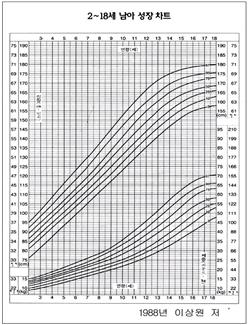
그림 3-188. 2~18세 한국 남아들의 체중과 신장의 성장차트와 백분위수.
Copyright ⓒ 2012 John Sangwon Lee, MD., FAAP

그림 3-189. 2~18세 한국 여아들의 체중과 신장의 성장차트와 백분위수.
Copyright ⓒ 2012 John Sangwon Lee, MD., FAAP
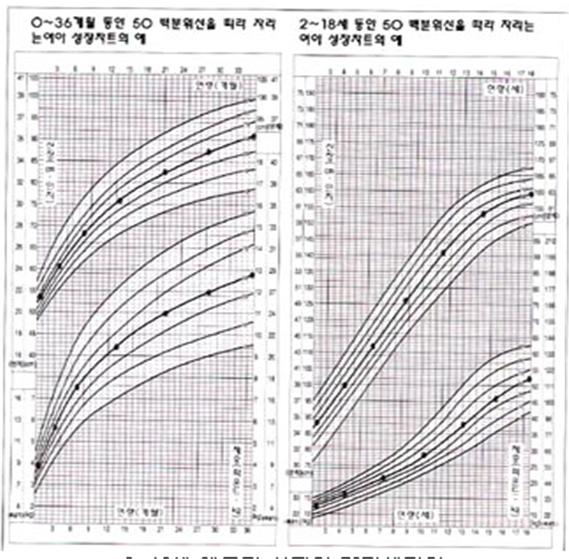
그림 3-190. 0~18세 체중과 신장이 50퍼센타일 백분위선을 따라 성장하는 한국 여아의 성장차트의 예.
Copyright ⓒ 2012 John Sangwon Lee, MD., FAAP
- 유아들의 체중과 신장을 잰다.
- 잰 체중 치와 신장 치를 성장차트 체중·신장 백분위선에 그려 넣고 그 유아들의 체중 치와 신장치가 성장차트 체중·신장 백분위선 상 어디에 있는지 알아본다.
- 체중과 신장이 과거와 같게 또는 거의 같은 성장차트 체중·신장 백분위선을 따라 전과 같이 계속 증가하면서 정상적으로 잘 자라는지 알아본다.
| 소아청소년 예측 체중 신장과 소아청소년 예측 체중 신장 계산공식 참조 |
| 5~6세 유아들의 발육 |
1. 5~6세 유아들의 신체 발육
- 두 발을 번갈아 뛸 수 있다.
- 한 발로 몇 분 동안 서 있을 수 있다.
- 발끝으로 딛고 달릴 수 있다.
- 튀는 공을 잡을 수 있다.
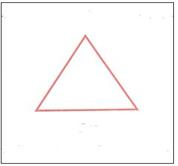
그림 3-191. 5세 유아들의
대부분은 삼각형을 보고 그릴 수 있다.
Copyright ⓒ 2012 John Sangwon Lee, MD., FAAP
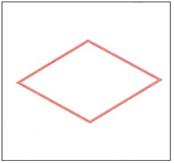
그림 3-192. 6세 아이들의 대부분은 마름모꼴을 보고 그릴 수 있다.
Copyright ⓒ 2012 John Sangwon Lee, MD., FAAP
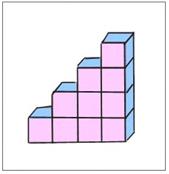
그림 3-193. 6세 유아들의 대부분은 장난감 정육면체 블록 10개로 계단형태를 만들 수 있다.
Copyright ⓒ 2012 John Sangwon Lee, MD., FAAP
2. 5~6세 유아들의 손 발육
- 이 나이의 유아들의 대부분은 열까지 정확히 셀 수 있다.
- 그들에게 종이와 연필을 주고 사람을 그려보라고 하면 사람의 머리 모양과 몸통 형태와 거의 비슷하게 머리와 몸통을 그릴 수 있다.
- 정삼각형이나 정사각형을 보고 그릴 수 있다.
3. 5~6세 유아들의 언어 발육
- 4(네) 가지 이상 색깔을 정확히 구별할 수 있다.
- 큰돈과 작은 돈을 구별할 수 있다.
- 그림책에 있는 간단한 그림과 내용을 보고 그림과 내용을 대략 이야기할 수 있다.
- ‘부엌에 가서 숟가락을 가지고 와서 밥을 먹어요.’라는 세 가지 부탁을 한꺼번에 부탁해도 무슨 뜻인지 알아듣고 시키는 대로 네 가지 심부름을 실행할 수 있다.
- 글로 써있는 자기 이름을 보고 자기 이름인 줄을 알 수 있다.
- 문법에 맞게 간단한 문장을 정확히 말할 수 있다.
- 오늘과 어제를 구별할 수 있다.
4. 5~6세 유아들의 사회성 발육
- 부모나 부모 이외 식구가 도와주지 않아도 혼자서 옷을 입고 벗을 수 있다.
- 단어의 뜻을 많이 알고, 그 단어를 적절히 써서 말할 줄 안다.
- 글자를 보고 베낄 수 있다.
- 다른 아이들과 함께 놀기를 좋아한다.
- 신발을 좌우 쪽을 가려 신을 수 있다.
- “생후 1개월~6세의 영유아들의 발육 이정표” 참조
| 5~6세 유아들의 장난감 |
장난감 참조
표 3-38. 소아청소년 나이에 따라 쓰는 최소 단어 수
| 나이 | 단어 수 |
| 1년 | 3 |
| 1년 3개월 | 10 |
| 1년 6개월 | 20 |
| 2년 | 272 |
| 2년 6개월 | 446 |
| 3년 | 863 |
| 3년 6개월 | 1,222 |
| 4년 | 1,540 |
| 5년 | 2,072 |
| 6년 | 2,562 |
|
5~6세 유아들의 영양 |
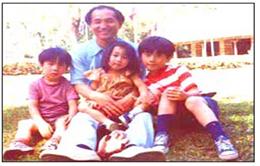
사진3-194.신체적 접촉사랑, 눈길 접촉사랑을 조건 없이 진정한 사랑을 충분히 받고 자라야 아이들은 최선을 다하고 최고가 되고 행복하게 자란다.
집중적 관심적 사랑을 충분히 받아야 건전한 자존심을 갖는 아이들로 성장한다.
Copyright ⓒ 2012 John Sangwon Lee, MD, FAAP
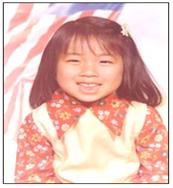
사진3-195.자부심이 풍부한 5세 여아.
Copyright ⓒ 2012 John Sangwon Lee, MD., FAAP
- 부모들이나 식구들이 먹는 밥상 음식물을 주식으로 하루 세 번, 주식과 주식 사이에 1~2번 간식을 주면 된다.
| 5~6세 유아들의 양호 |
- 이 연령층의 유아들에게 교통사고, 화상사고, 익사 사고, 독극물중독사고, 약물중독사고, 화학물질 중독사고 등 안전사고가 잘 생길 수 있다.
- 그런 안전사고를 미연에 예방해야 한다.
- 4~7세까지 불활성 소아마비 백신 예방접종(IPV)을 적어도 4차,
- DTaP 백신 예방접종을 5차,
- 홍역과 풍진과 볼거리 백신 예방접종(MMR)을 2차,
- 히브 백신 예방접종(Hib)을 4차,
- B형 간염 백신 예방접종(HepB)을 3차,
- 수두 백신 예방접종(VAR)을 2차,
- 폐렴 백신 예방 접종 (PVC)을 4~5차 접종받아야 한다.
- 로타(RotaTeq) 예방접종을 3차, 로타릭스(Rotarix)예방접종은 2차,
- A형 간염 백신 예방접종(HepA)을 2차 받는다.
- 뇌수막염 백신 MCV4 예방접종은 2~6세에 해준다.(아래 참조)
- 앞서 권장한대로 DTaP 예방접종을 전부 다 받았으면 맨 마지막 DTaP 예방접종을 해준 후로부터 10년이 될 때 디프테리아, 파상풍과 백일해 백신 예방접종을 받기 위해 디프테리아, 파상풍 백일해 백신 예방접종약(Tdap)으로 예방접종 받는다.
- 로타바이러스성 위장염과 다른 전염병을 예방할 수 있는 종합 접종 백신, ProQuad, Pediarix, Aducel, Boostrix 백신 등 종합백신이 있다.
- 새 종합 예방접종 백신으로 필요에 따라 접종받는다.
- “Menhibrix 백신(2012년 6월)-미 FDA Neisseria meningitidis 혈청형 C, Y와 Haemophilus influenzae type b (Hib) 로 생기는 패혈증과 뇌수막염을 예방 할 수 있는 종합 백신이다. 생후 2, 4, 6개월과 12 ~15 개월에 총 4화 접종받을 수 있고 최초 접종은 생후 6주에 접종 받을 수 있다. 출처 Physician’s First Watch for June 15, 2012(위 참조)
- 청력과 시력검사를 소아청소년과에서 해마다 받고 유치원에 입학시킬 준비를 해야 한다.
| 5~6세 유아들의 예방접종 |
예방접종 참조
| 5~6세 유아자녀 사랑 |
자녀 사랑 참조
Growth and development of 5-6-year-old children
Growth of 5-6-year-olds
Table 3-36. Percentiles of weight and height of 5-year-old Korean preschoolers percentile
표 3-36. 5세 한국 유아들의 체중과 신장의 백분위수
|
percentile
gender |
3 | 10 | 25 | 50 | 75 | 90 | 97 | |
| boy | weight (kg) | 12.70 | 14.20 | 15.50 | 16.80 | 18.00 | 19.20 | 20.70 |
| height(cm) | 94.0 | 97.4 | 101.8 | 105.0 | 109.0 | 112.0 | 114.9 | |
| girl | weight (kg) | 12.60 | 13.50 | 14.70 | 16.00 | 17.50 | 18.90 | 19.80 |
| height(cm) | 92.8 | 96.2 | 100.2 | 103.6 | 107.5 | 110.7 | 113.9 |
Table 3-37. Percentiles of weight and height of Korean preschooler 5 years and 6 months percentile표 3-37. 5년 6개월 한국 유아들의 체중과 신장의 백분위수
|
percentile
gender |
3 | 10 | 25 | 50 | 75 | 90 | 97 | |
| boy | weight (kg) | 13.60 | 14.78 | 16.20 | 17.70 | 18.00 | 20.30 | 22.00 |
| height(cm) | 96.0 | 99.7 | 104.1 | 108.1 | 111.1 | 114.5 | 117.0 | |
| girl | weight (kg) | 13.50 | 14.70 | 15.70 | 17.01 | 18.50 | 20.00 | 21.50 |
| height(cm) | 95.4 | 99.5 | 103.2 | 106.8 | 110.1 | 113.4 | 116.5 |

Figure 3-188. Growth charts and percentiles of weight and height for Korean boys aged 2 to 18 years old. Copyright ⓒ 2012 John Sangwon Lee, MD., FAAP

Figure 3-189. Growth charts and percentiles of weight and height for Korean girls aged 2 to 18 years. Copyright ⓒ 2012 John Sangwon Lee, MD., FAAP

Figure 3-190. An example of a growth chart for Korean girls aged 0-18 years, whose weight and height grow along with the 50th percentile. Copyright ⓒ 2012 John Sangwon Lee, MD., FAAP
• Weigh the preschoolers and measure their height.
• Draw the measured weight and height values on the weight and height percentiles of the growth chart, and find out where the weight and height values of the preschoolers are on the weight and height percentiles of the growth chart.
• Weight percentile and height percentile of preschoolers are the same as in the past or nearly the same as in the past growth chart and follow the weight and height percentiles to see if they are growing normally while continuing to increase as before. Refer to the calculation formula for the predicted weight and height for children and adolescents and the predicted weight for children and adolescents.
Development of 5-6-year-old preschoolers
1. Physical development of 5-6-year-old infants
• Able to jump alternately on both feet.
• Able to stand on one leg for several minutes.
• Able to run on tiptoe.
• Catch the bouncing ball.

Figure 3-91. Most 5-year-olds can see and draw triangles. Copyright ⓒ 2012 John Sangwon Lee, MD., FAAP

Figure 3-192. Most 6-year-olds can see and draw rhombuses. Copyright ⓒ 2012 John Sangwon Lee, MD., FAAP

Figure 3-193. Most 6-year-olds can build a staircase with 10 toy cube blocks. Copyright ⓒ 2012 John Sangwon Lee, MD., FAAP
2. Hand development of 5-6-year-old preschoolers
• Most children this age can count to ten accurately.
• If you give them paper and a pencil and ask them to draw a person, they can draw a head and body that closely resembles the shape of a person’s head and body.
• Can see and draw an equilateral triangle or square.
3. Language development of 5-6-year-olds
• Can accurately distinguish 4 (four) or more colors.
• Can distinguish between big money and small money.
• Can talk about pictures and contents by looking at simple pictures and contents in picture books.
• Even if you ask for three requests at once, ‘Go to the kitchen, bring a spoon, and eat’, he can understand what they mean and execute four errands as directed.
• You can tell that it is your name by looking at your name written on it.
• Can say simple sentences accurately according to grammar.
• Can distinguish between today and yesterday.
4. Social development of 5-6-year-olds
• You can get dressed and undressed by yourself without the help of a parent or other family member.
• Knows a lot of the meaning of words, and knows how to use them appropriately.
• Can see and copy letters.
• Likes to play with other children.
• Shoes can be worn with the left and right sides covered.
• See “Developmental Milestones for Infants 1 Month to 6 Years Old”
Toys for 5-6-year-olds-toy reference
Table 3-38. A minimum number of words used by children and adolescents age word count
표 3-38. 소아청소년 나이에 따라 쓰는 최소 단어 수
| age | word count |
| 1 year old | 3 |
| 1 year 3 months | 10 |
| 1 year 6 months | 20 |
| 2 years | 272 |
| 2 year 6 months | 446 |
| 3 years | 863 |
| 3 years 6 months | 1,222 |
| 4 years | 1,540 |
| 5 years | 2,072 |
| 6 years | 2,562 |

Picture 3-194. Children grow up doing their best, becoming the best, and growing up happily when they receive enough genuine love unconditionally for physical contact love and eye contact love. When they receive enough focused attention love, they grow into children with healthy self-esteem. Copyright ⓒ 2012 John Sangwon Lee, MD, FAAP

Picture 3-195. A proud 5-year-old girl. Copyright ⓒ 2012 John Sangwon Lee, MD., FAAP
• They can eat their parent’s or family members’ meals three times a day as the main meal, and snacks 1-2 times a day between the main meals. Good for 5-6-year-olds
• Safety accidents such as traffic accidents, burn accidents, drowning accidents, poison poisoning accidents, drug poisoning accidents, and chemical substance poisoning accidents are likely to occur in this age group.
• Such accidents should be prevented in advance.
• At least 4 doses of inactive polio vaccine (IPV) for children 4-7 years of age;
• 5th dose of DTaP vaccine;
• 2nd dose of measles, rubella, and mumps vaccine (MMR);
• 3rd-4th dose of Hib vaccine (Hib);
• 3rd dose of hepatitis B vaccine (HepB);
• 2nd dose of varicella vaccine (VAR);
• You should get 4-5 doses of the Pneumonia Vaccine Vaccination (PVC).
• 3rd dose of RotaTeq vaccination, 2nd dose of Rotarix vaccination or Vaxelis,
• Get a second dose of the hepatitis A vaccine (HepA).
• Meningitis Vaccine MCV4 vaccination is given accordingly.
• If you have received all of the DTaP vaccines as recommended above, get vaccinated with diphtheria, tetanus, and pertussis vaccine (Tdap) at 10 years from the last DTaP vaccination.
• Combined vaccines that can prevent rotavirus gastroenteritis and other infectious diseases, including ProQuad, Pediarix, Aducel, Vaxelis, and Boostrix vaccines, are available.
• Get vaccinated as needed with a new comprehensive immunization vaccine.
• “Menhibrix Vaccine (June 2012) – A comprehensive vaccine that can prevent sepsis and meningitis caused by Neisseria meningitidis serotypes C and Y and Haemophilus influenzae type b (Hib) by the US FDA. A total of 4 doses are given at 12-15 months of age, and the first dose is given at 6 weeks of age Source Physician’s First Watch for June 15, 2012 (see above)
• Have hearing and vision tests done annually by the Department of Pediatrics and be prepared for kindergarten.
출처 및 참조문헌
- Nelson Textbook of Pediatrics 22ND Ed
- The Harriet Lane Handbook 22ND Ed
- Growth and development of the children
- www.drleepediatrics.com 제1권 소아청소년 응급 의료
- www.drleepediatrics.com 제2권 소아청소년 예방
- www.drleepediatrics.com 제3권 소아청소년 성장 발육 육아
- www.drleepediatrics.com 제4권 모유,모유수유, 이유
- www.drleepediatrics.com 제5권 인공영양, 우유, 이유식, 비타민, 미네랄, 단백질, 탄수화물, 지방
- www.drleepediatrics.com 제6권 신생아 성장 발육 육아 질병
- www.drleepediatrics.com제7권 소아청소년 감염병
- www.drleepediatrics.com제8권 소아청소년 호흡기 질환
- www.drleepediatrics.com제9권 소아청소년 소화기 질환
- www.drleepediatrics.com제10권. 소아청소년 신장 비뇨 생식기 질환
- www.drleepediatrics.com제11권. 소아청소년 심장 혈관계 질환
- www.drleepediatrics.com제12권. 소아청소년 신경 정신 질환, 행동 수면 문제
- www.drleepediatrics.com제13권. 소아청소년 혈액, 림프, 종양 질환
- www.drleepediatrics.com제14권. 소아청소년 내분비, 유전, 염색체, 대사, 희귀병
- www.drleepediatrics.com제15권. 소아청소년 알레르기, 자가 면역질환
- www.drleepediatrics.com제16권. 소아청소년 정형외과 질환
- www.drleepediatrics.com제17권. 소아청소년 피부 질환
- www.drleepediatrics.com제18권. 소아청소년 이비인후(귀 코 인두 후두) 질환
- www.drleepediatrics.com제19권. 소아청소년 안과 (눈)질환
- www.drleepediatrics.com 제20권 소아청소년 이 (치아)질환
- www.drleepediatrics.com 제21권 소아청소년 가정 학교 간호
- www.drleepediatrics.com 제22권 아들 딸 이렇게 사랑해 키우세요
- www.drleepediatrics.com 제23권 사춘기 아이들의 성장 발육 질병
- www.drleepediatrics.com 제24권 소아청소년 성교육
- www.drleepediatrics.com 제25권 임신, 분만, 출산, 신생아 돌보기
- Red book 29th-31st edition 2021
- Nelson Text Book of Pediatrics 19th- 21st Edition
- The Johns Hopkins Hospital, The Harriet Lane Handbook, 22nd edition
- 응급환자관리 정담미디어
-
소아가정간호백과–부모도 반의사가 되어야 한다, 이상원
-
Neonatal Resuscitation American heart Association
-
Neonatology Jeffrey J.Pomerance, C. Joan Richardson
-
Pediatric Resuscitation Pediatric Clinics of North America, Stephen M. Schexnayder, M.D.
-
Pediatric Critical Care, Pediatric Clinics of North America, James P. Orlowski, M.D.
-
Preparation for Birth. Beverly Savage and Dianna Smith
-
Infectious disease of children, Saul Krugman, Samuel L Katz, Ann A. Gershon, Catherine Wilfert
- 소아과학 대한교과서
- Growth and Development of Children, Eighth Edition, George H. Lowrey, Yearbook Medical Publishers
- Growth and Development of Children, Fifth Edition, E. H. Watson and G. H. Lowrey, Yearbook Medical Publishers
- Other
|
Copyright ⓒ 2015 John Sangwon Lee, MD, FAAP 미국 소아과 전문의, 한국 소아청소년과 전문의 이상원 저 “부모도 반의사가 되어야 한다”-내용은 여러분들의 의사로부터 얻은 정보와 진료를 대신할 수 없습니다. “The information contained in this publication should not be used as a substitute for the medical care and advice of your doctor. There may be variations in treatment that your doctor may recommend based on individual facts and circumstances. “Parental education is the best medicine.” |